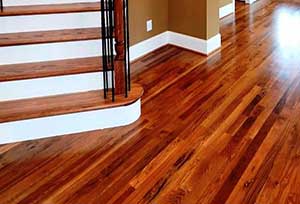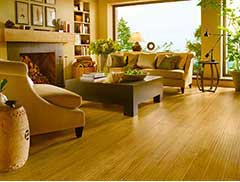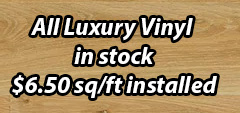 The look of natural cork is more of an informal appearance that some say tends to show more wear over time, though this antique or rustic appearance goes well with some styles of decor. Beyond the style of natural cork, today’s cork products come in many different colors, shapes & styles, some which mimick other materials like marble, tile, stone & wood. The main advantages of cork are it’s softness, warmth, comfort & quietness as cork offers resilience, sound proofing & thermal insulation. Other products like hardwood & bamboo are harder & more resistant to scratches & dings, but do not have those qualities. Here’s a list of all the qualities of cork flooring.
The look of natural cork is more of an informal appearance that some say tends to show more wear over time, though this antique or rustic appearance goes well with some styles of decor. Beyond the style of natural cork, today’s cork products come in many different colors, shapes & styles, some which mimick other materials like marble, tile, stone & wood. The main advantages of cork are it’s softness, warmth, comfort & quietness as cork offers resilience, sound proofing & thermal insulation. Other products like hardwood & bamboo are harder & more resistant to scratches & dings, but do not have those qualities. Here’s a list of all the qualities of cork flooring.
• Beautiful, wide variety of colors, designs, grain patterns & beveled edges; some suppliers offer customization of shapes, colors & patterns making possible tile mosaics & patterns like parquet & herringbone
• Organic look, environmentally friendly, plant based, biodegradable, sustainable – cork bark regrows every 9 years, no deforestation, no need to cut trees
• Naturally water resistant, natural suberin wax within the cork cells protects against moisture; polyurethane based finishes also increase water resistance
• Antimicrobial, hypoallergenic, fire resistant, resists mold, mildew, rodents, termites & other insects
• Insulates & maintains temperature, helping with hvac costs, suitable for radint floor heating, doesn’t get cold like tile, wood & marble
• Comfortable, soft, resilient & warm, great for kids or elderly to cushion a fall
• Quiet, soundproofs, absorbs impacts, reduces sound of steps; cork underlayment is also used for this purpose & for thermal insulation with other flooring types
• Low maintenance, just sweep or vacuum & damp mop, recoat polyurethane every 3-5 years
• Durable & can last for many years – some say 50-75 while others estimate 15-20 if not carefully maintained
• Not hard like wood so may dent or scratch easier, felt should be placed on furniture legs
• Resilient, doesn’t dent easily but very heavy furniture legs can leave impressions if not placed on coasters
• Pets with nails can scratch & cause wear but more coats of polyurethane can be applied to increase protection
• Natural style cork masks scratches, hides dirt & seams very well, wear tends to not stand out
• Can fade – constant exposure to sunlight can cause fading, some products have enhanced UV resistant finishes
• Refinishable – solid cork can be recoated with polyurethane to restore the finish & can also be sanded to remove deeper scratches & refinished with new stain & polyurethane just like hardwood (solid cork only, not engineered cork products)
• Flexible Install – can be installed over most any flat surface including concrete or existing flooring; floating tiles & planks can be easily disassembled or replaced
• Easy to install for most DIY homeowners, comes in adhesive peel & stick backing or click lock floating planks, can also be glued down which is best done by a pro
• Reasonably priced – Cost for cork flooring material is generally a little less than hardwood
• Warranties – some products offer limited manufacturer residential warranties for 15 years to lifetime
Great Places to Install Cork Flooring
Cork floors are soft, cushiony & comfortable to stand on making it great for kitchen’s or any place where one stands for long periods. Children’s rooms & where elderly people live are good places to have soft flooring where someone could fall. For any floors above people where quietness is desired cork has great sound proofing ability. And for any rooms where floors tend to get cold cork’s thermal insulation keeps them warm.
Manufacturing Of Cork
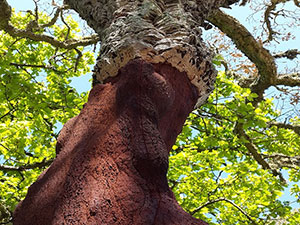 Cork comes from the bark of cork trees mostly from Portugal & then Spain which established cork forests for the wine industry since days of yore. It has had many uses such as for bottles, shoe soles & floats since thousands of years ago. Cork has been used for flooring since the early 20th century. In recent years with technology innovations cork has gained popularity, becoming more durable & designable.
Cork comes from the bark of cork trees mostly from Portugal & then Spain which established cork forests for the wine industry since days of yore. It has had many uses such as for bottles, shoe soles & floats since thousands of years ago. Cork has been used for flooring since the early 20th century. In recent years with technology innovations cork has gained popularity, becoming more durable & designable.
The cork tree is unique, unlike other trees it doesn’t die when it’s bark is removed but instead grows it back. The regenerative bark is skillfully trimmed from cork Oak trees called Quercus Suber which regrow their trimmed bark every 9 or so years. Various grades of bark are removed & processed in various ways for different uses including for flooring. The majority of harvested cork is used for production of cork bottle stoppers. Most cork flooring is made from the byproduct of this production.
No deforestation is required for cork harvesting & it’s therefore environmentally beneficial. Cork forests reduce carbon emissions by absorbing millions of tons of carbon. The trees are not cut down to get materials such as trees which are cut for wood flooring. They can live for 200 years & in a lifetime provide materials for many more floors than trees which are cut for hardwood flooring. In this regard cork is similar to bamboo as a renewable material which regrows many times from the same plant. Bamboo is harder making it more resistant to scratches whereas cork is softer making it more comfortable & with the quality of insulating sound & temperature.
Cork Flooring Construction
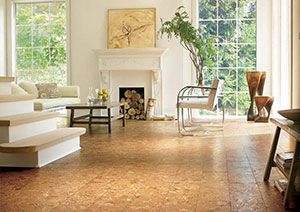 Cork is one of the lightest flooring materials made of many millions of tiny, unbreakable, resilient cells that are 50% air & restore their original form after being compacted by high pressure. The cork cells are naturally permeated with natural suberin wax which makes cork water resistant & able to float on water. Cork flooring is made either as solid slices of agglamorated cork – ground cork pressed together with resins into blocks & then sliced into sheets, or as engineered cork planks. These are floating planks made of a high density fiberboard core sandwiched between layers of either agglamorated cork or whole unprocessed cork. Many engineered cork products have a cork veneer (decorative top layer) which can mimick the look of hardwood, marble & stone.
Cork is one of the lightest flooring materials made of many millions of tiny, unbreakable, resilient cells that are 50% air & restore their original form after being compacted by high pressure. The cork cells are naturally permeated with natural suberin wax which makes cork water resistant & able to float on water. Cork flooring is made either as solid slices of agglamorated cork – ground cork pressed together with resins into blocks & then sliced into sheets, or as engineered cork planks. These are floating planks made of a high density fiberboard core sandwiched between layers of either agglamorated cork or whole unprocessed cork. Many engineered cork products have a cork veneer (decorative top layer) which can mimick the look of hardwood, marble & stone.
Floating planks are called ‘floating’ not because cork can float on water, but because they can be laid down or ‘floated’ freely over existing flooring, clicking together without nails or glue, as does laminate or luxury vinyl planks. Like hardwood planks, they come either prefinished with polyurethane based finish or unfinished which need to be finished with a few coats of polyurethane on site after installation. Cork flooring comes in various sizes & the most common is 12″ x 36″ planks or 12″ x 12″ square tiles.
When buying cork flooring look for products which are third party certified to be formaldehyde free & with non toxic adhesives & finishes (products from Europe not China). Certifications such as GreenGuard Gold and Global GreenTag are common. FSC also certifies products as formaldehyde free & having sustainable harvesting practices for the wood fiberboard core.
Cork Flooring Durability
 Some manufacturers offer a highly durable longer lasting finish, though cork finish can be restored with a few coats of polyurethane. Pet nails can do damage to any floor, though cork is a softer type of material which can be more prone to scratches from pets. However, scratching of the cork really depends on how thick the polyurethane finish layer is. The more coats of polyurethane that are applied to the finish, the better protected the floor will be, and more polyurethane can always be added.
Some manufacturers offer a highly durable longer lasting finish, though cork finish can be restored with a few coats of polyurethane. Pet nails can do damage to any floor, though cork is a softer type of material which can be more prone to scratches from pets. However, scratching of the cork really depends on how thick the polyurethane finish layer is. The more coats of polyurethane that are applied to the finish, the better protected the floor will be, and more polyurethane can always be added.
As mentioned, solid cork can also be sanded & refinished several times to remove scratches & renew the finish or even restain a faded floor. Prefinished cork products come with UV resistant finish to resist fading, otherwise cork can fade in direct sunlight.
Natural cork patterns tend to mask light stains & scratches. Cork doesn’t dent easily though it’s still good to use felt furniture pads. Durability ratings range from AC1 for residential use to AC5 the most durable for industrial use. Most durable products have a top wear layer 2-3mm thick.
Water resistance
Regular cork products that aren’t specified as waterproof are not recommended for use where there’s moisture regularly. Cork is highly water resistant but not completely waterproof as is LVT luxury vinyl tile. Like wood flooring, you should wipe up spills promptly & not leave water sitting. Flooding can warp and discolor cork & high humidity can cause buckling. Overall cork is suitable for most temperature controlled areas. Some cork flooring products are manufactured with greater water resistance using special binders.
However, in 2019 100% waterproof cork planks became available that click together and can be floated over any flat surface. These are suitable in high moisture areas including bathrooms & laundry rooms. This recent development in waterproofing of engineered cork planks has made it suitable for practically everywhere in the home. The engineered cork planks are constructed with a fiberboard middle layer which is saturated with HDPE plastic for full water resistance. HDPE is PVC & formaldehyde free. In very wet areas it is recommended to glue down planks for the utmost protection from water getting into seams & underneath the planks.
Maintenance
 Sweep or vacuum & damp mop regularly. Natural style cork tends to hide dirt, stains & scratches. Cork which is surface stained with colors that contrast the natural color within won’t hide scratches so easily. Avoid scratches by putting felt tips on furniture legs. Very heavy furniture can leave permanent dents so it’s advisable to use coasters or boards underneath. Clean with Bona Hardwod Floor Cleaner.
Sweep or vacuum & damp mop regularly. Natural style cork tends to hide dirt, stains & scratches. Cork which is surface stained with colors that contrast the natural color within won’t hide scratches so easily. Avoid scratches by putting felt tips on furniture legs. Very heavy furniture can leave permanent dents so it’s advisable to use coasters or boards underneath. Clean with Bona Hardwod Floor Cleaner.
Polyurethane finish also protects the cork & can easily be renewed to eliminate scuffs, scratches & restore shine. The more coats of polyurethane, the greater the protection. Water based polyurethane like Bona can be used to stay environmentally friendly while minimizing odor & VOC’s. Most floors need recoating about every 3-10 years. The surface is lightly sanded before applying the polyurethane. Deep scratches can be fixed with wood putty which blends in with natural cork styles. Cork floors can also be sanded & refinished like hardwood to remove deeper scratches, though this doesn’t apply to engineered cork which has only a thin layer of cork on top.
Installation
It’s wise to order about 10% extra of any type of flooring material to accomodate for any mistakes and to have future replacement tiles in case any ever get damaged. Cork flooring should be acclimated for a few days before installing to adjust to the room temperature & humidity, as is done with wood flooring which can expand or contract with changes in temperature & humidity. Avoid installation in high humidity.
The three types of installation are self adhesive, click lock floating planks & glue down which is best done by a pro. Self adhesive requires a flat, thoroughly dry, clean surface for the adhesive to properly stick to. It can be installed directly over existing flooring, though wood & concrete surfaces should first be coated with a primer for proper adhesion. This video shows installation of vinyl peel & stick tiles & the same method is used for cork peel & stick tiles.
Floating planks can be installed over any flat surface including existing flooring. Using a foam underlayment helps to fill in any imperfections in the levelness of the floor. In some cases the manufacturer recommends using a vapor barrier plastic sheeting over concrete. A hammer or mallet and tapping block made of floor material are used to click the planks together. Start in one corner and work towards another corner, row by row. Remove any baseboards and leave .5 inch gap to allow room for expansion of the floor which can happen because of changes in temperature & humidity. The gap is hidden when baseboards are replaced, otherwise if there’s no baseboards use a .75 inch quarter round to hide the gap. The last step after the tiles are laid if they are unfinished is to coat the floor with a few coats of polyurethane. We mostly use Bona water based polyurethane for quick drying & low odor. More details here on installing cork flooring.
